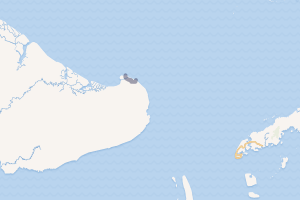Dent Peninsula
The Dent Peninsula (Malay: Semenanjung Dent) is a peninsula in eastern Sabah, Malaysia. It consists of hills and broad coastal areas.[2] The Peninsula is also previously considered as a volcanic arc of the region which have since migrated southward to Semporna Peninsula.[3]

Location of Dent Peninsula in Sabah | |
 Dent Peninsula Dent Peninsula within Malaysia | |
| Etymology | Semenanjung Dent |
|---|---|
| Geography | |
| Location | |
| Coordinates | 5°12′32.464″N 118°56′10.892″E |
| Archipelago | Maritime Southeast Asia |
| Adjacent bodies of water | |
| Highest point | Mount Hatton 570 metres (1,870 ft)[1] |
| Administration | |
| State | |
Geology
Volcanic activity in the tertiary causing rise to andesite and dacite in the area around Bakapit in the southern area of the peninsula.[4][5] The rocks in east of Lahad Datu are mixed volcanic and sedimentary: tuffaceous sandstones and conglomerate mixed with Ayer, Tabanak and Tungku formations materials of shales, mudstones and sandstones.[4] Inner necritic to littoral deposits at the east of the peninsula consist of mudstone, clay and coral limestone with Sabahat (Middle Miocene and Early Pliocene) and Ganduman (Early Pliocene to Late Pliocene) formations materials of lignite, marl and conglomerate.[4] The Ganduman formation displays well preserved outcrops of delta plain deposits grading to shallow marine deltaic and holomarine eastward while the Sabahat is represented by the clinoform and downlap seismic packages.[6] The Togopi formation on the onshore of the peninsula is mainly made of marls and preserves Plio-Pleistocene sedimentary sequences which have a relatively high coral diversity.[6][7] Based on organic geochemical and petrological analyses, both formations of Sabahat and Ganduman found to be gas-prone source rocks.[8][9] The narrow continental shelf fronting the coastal areas of both Dent and Semporna Peninsulas also could be exposed to future tsunamis with the active fault in the eastern coast.[10]
Climate and biodiversity
The peninsula especially in the northern generally received mean annual rainfall ranging from 2,000 millimetres to 2,500 millimetres. In the southern coast, the area received annual rainfall ranging from 1,500 millimetres to 2,000 millimetres while the Tungku area received less than 1,500 millimetres.[11] Located in the centre of the peninsula is the Tabin Wildlife Reserve which is a forest reserve area with variety of protected species.[1]
References
- "Class I Protection Forest Reserve (FR)". Government of Sabah. 22 April 2005. Retrieved 29 May 2019.
- Land Resource Study. Land Resources Division, Directorate of Overseas Surveys. 1975.
- Harminzah Mansor (2008). "Assessment of a Synrift Play in South Dent Graben (Offshore East Sabah)" (PDF). Postgraduate Studies Programme Thesis, Degree of Master of Science in Petroleum Geoscience: 9. Archived from the original (PDF) on 29 May 2019. Retrieved 29 May 2019 – via Universiti Teknologi Petronas.
- "General geology of Sabah [Dent Peninsula]". Government of Sabah. Retrieved 29 May 2019.
- C.S. Hutchison (7 November 2005). Geology of North-West Borneo: Sarawak, Brunei and Sabah. Elsevier. p. 305. ISBN 978-0-444-51998-6.
- Ismail Che Mat Zin (1994). "Dent Group and its equivalent in the offshore Kinabatangan area, East Sabah" (PDF). Bulletin of the Geological Society of Malaysia, Geological Survey of Malaysia: 127. Archived from the original (PDF) on 29 May 2019. Retrieved 29 May 2019 – via Geological Society of Malaysia.
- Jasmin V. M. Saw; Aaron W. Hunter; Kenneth G. Johnson; Abdul Hadi Abdul Rahman (14 November 2018). "Pliocene corals from the Togopi Formation of the Dent Peninsula, Sabah, northeastern Borneo, Malaysia". Alcheringa: An Australasian Journal of Palaeontology. doi:10.1080/03115518.2018.1510978 – via Taylor & Francis.
- Neville Seymour Haile; Nicholas Pin Yeh Wong (1965). The Geology and Mineral Resources of Dent Peninsula, Sabah. U.S. Government Printing Office.
- Khairul Azlan Mustapha; Wan Hasiah Abdullah (25 October 2013). "Petroleum source rock evaluation of the Sebahat and Ganduman Formations, Dent Peninsula, Eastern Sabah, Malaysia". Journal of Asian Earth Sciences, Department of Geology, Faculty of Science, University of Malaya. 76. doi:10.1016/j.jseaes.2012.12.003 – via ScienceDirect.
- John Kuna Raj (2007). "Tsunami threat to coastal areas of Sabah, East Malaysia" (PDF). Department of Geology, University of Malaya: 51. Archived from the original (PDF) on 29 May 2019. Retrieved 29 May 2019 – via Geological Society of Malaysia.
- "Annual rainfall pattern of Sabah [Dent Peninsula]". Government of Sabah. Retrieved 29 May 2019.